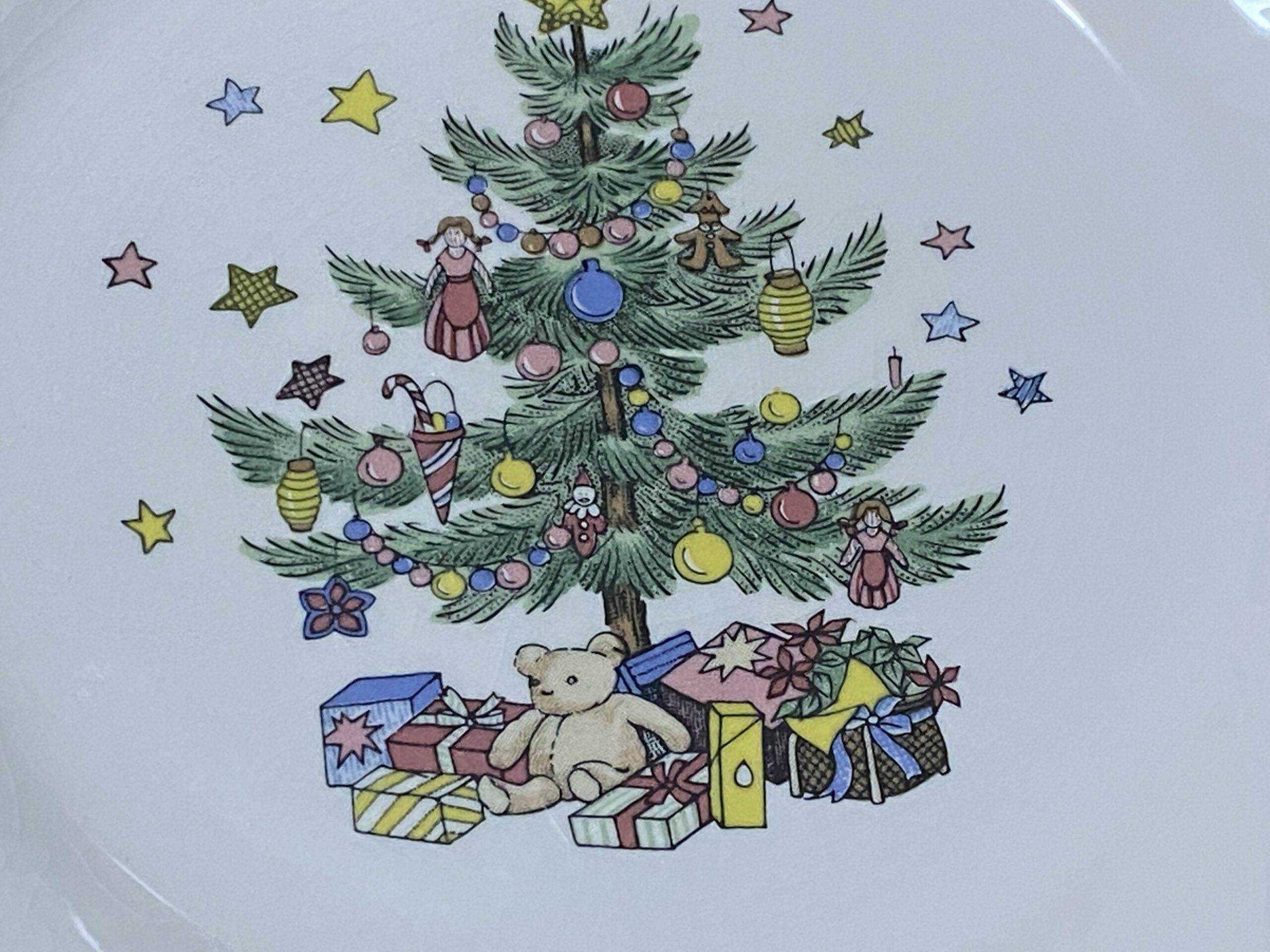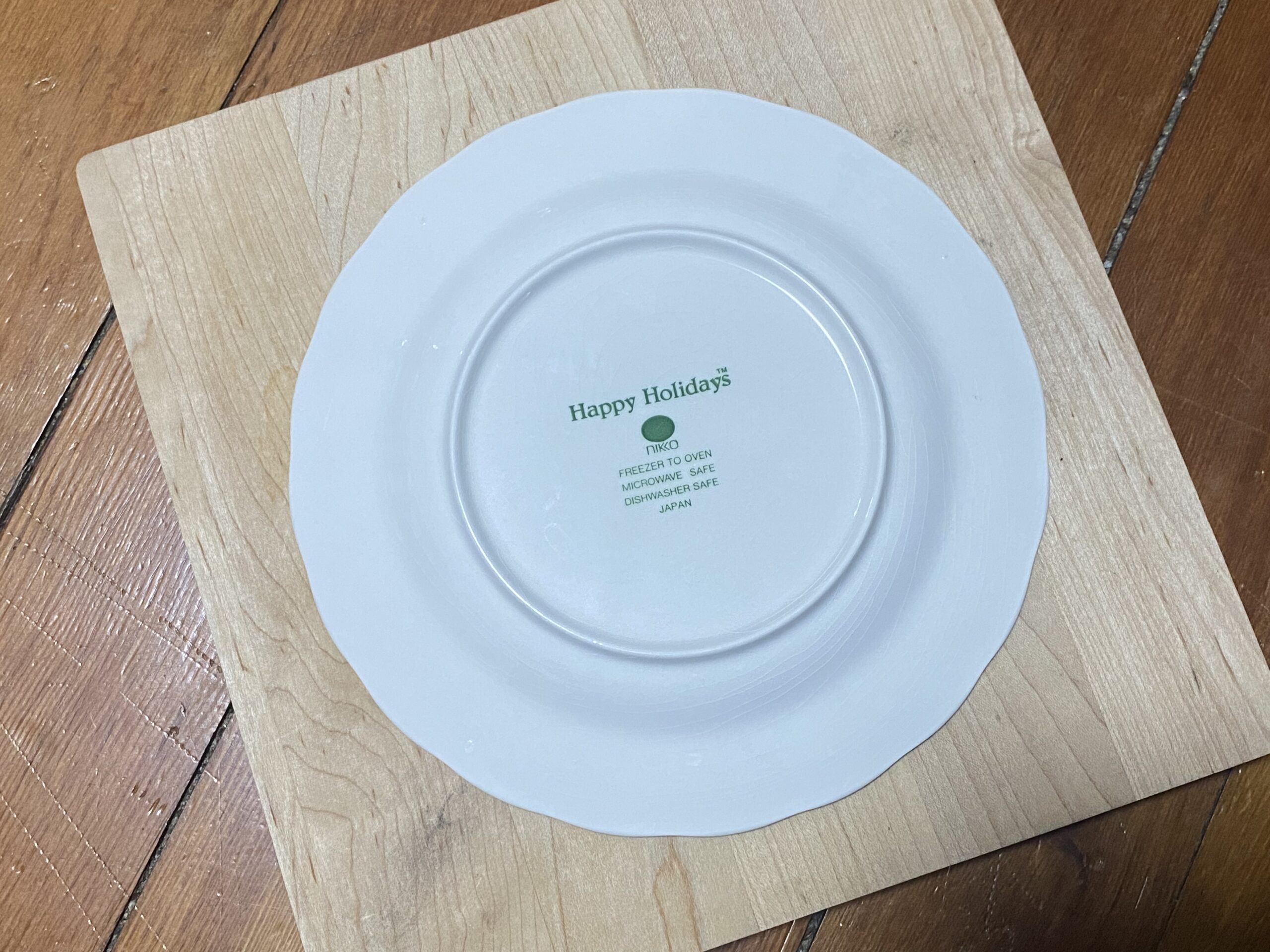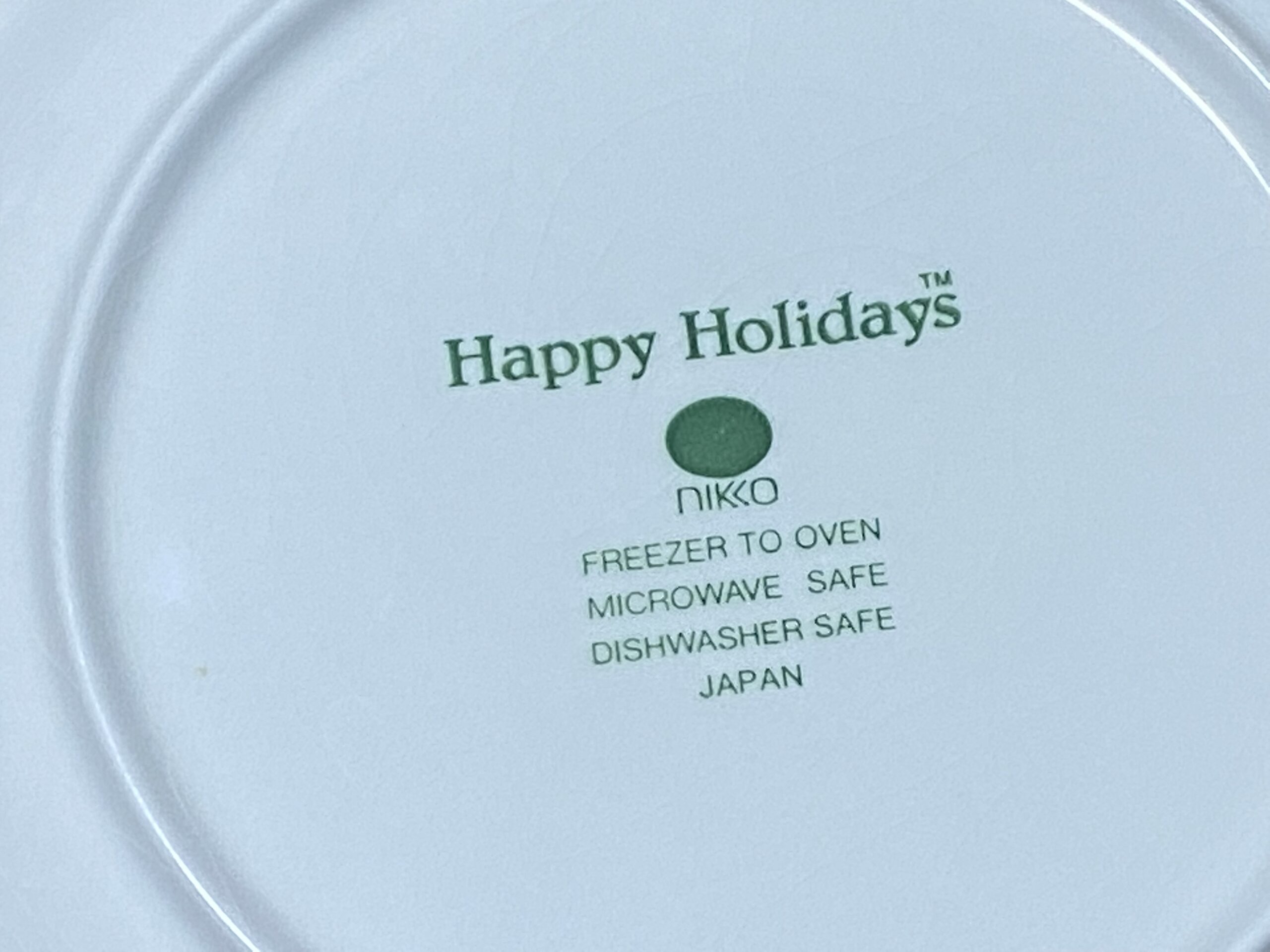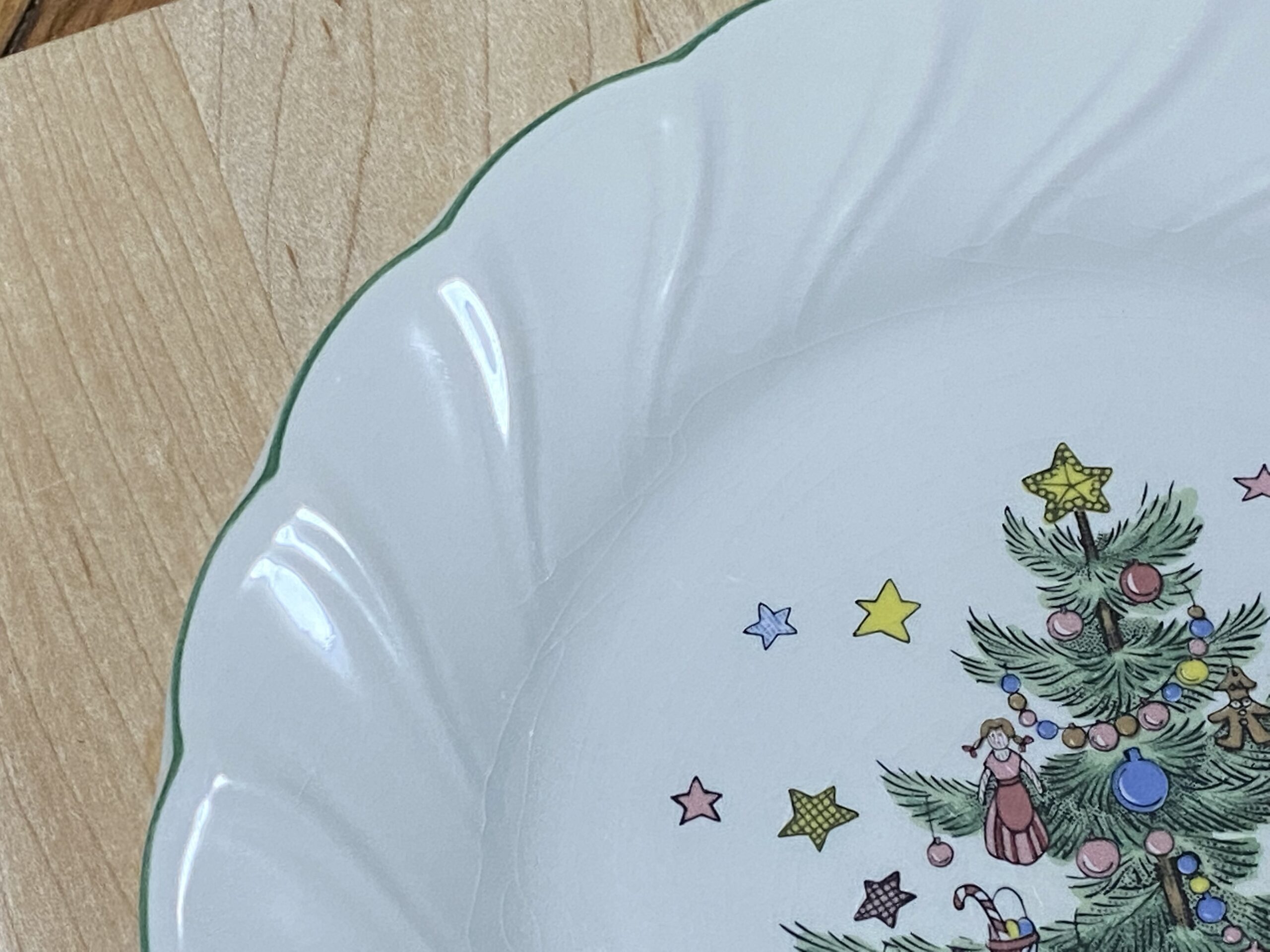c. 1980s Nikko Happy Holidays China Dish With Christmas Tree (Japan): 87,000 ppm Lead on the food surface (90 ppm & up is unsafe for kids)
Published: Sunday — July 3, 2022
Given all federal agencies agree there is no safe level of Lead exposure for humans and that in 2008, the Consumer Product Safety Commission set 90 ppm Lead as the limit for allowable Lead in the paint, glaze, or coating of an item intended for use by children, I would not personally be comfortable eating off of these dishes (and definitely would never let any child use one of these).
They may have been safe (determined by independent testing at the time of manufacture to be non-leaching for Lead) on the day they left the factory (about 40 years ago, now — as the owner reported that she purchased these in the 1980s), but there is no guarantee that over time, with age and use, they have not/will not become unsafe. This is especially possible if the item is used with heated foods — or acidic foods, such as tomato-based sauces, vinegar, or lemon juice, for example. Given these dishes are already “crazing” (the surface glaze on this one example is visibly deteriorating), they are likely leaching some of the Lead from the surface glaze when used today.
Now that we know for certain (using XRF testing) that there is a very high level of Lead in the glaze of this plate (see specific readings below), it is far simpler and less expensive to buy new dishes than it would be to send a dish like this to a lab for leach-testing to confirm how much of the Lead might be leaching from the dish at this point (and under what conditions) … so many years after they were manufactured! Consequently, in adopting a #KnowBetterDoBetter philosophy and a guiding principle of not allowing any Lead in your kitchen (and as a great first step in making a safer home for yourself and your family), I would recommend purchasing new dishes if you own these (and not using these dishes for food use purposes at all at this point). You can read more about these concerns specifically in this article — linked here.
“But I only want to use them on the holidays — is that okay?”
On this particular dish — given the age, combined with the Lead level and the degree of visible crazing in the glaze — I would say it is absolutely not safe to use, even “only for the holidays.” This is especially the case because of the design: A Christmas tree with presents and a teddy bear underneath — so the plate was likely made to be used (more than once) by a young child during the holiday season. Lead accumulates in our bodies from multiple sources over our lifetime, and if we can eliminate even one potential exposure source, we should. My children have permanent brain damage, learning disabilities, and other health impairments from Lead exposure. If you have the opportunity to protect your family from even incidental Lead exposure, in my opinion, that is an opportunity you should take. You can read more about the concern for cumulative exposure at this link. This link discusses symptoms of Lead exposure in adults, which may also be interesting to some readers.
Below are the full test results for the dish pictured.
Reading #1) Center of the food surface of the plate, on the Christmas tree design
60-second reading
- Lead (Pb): 87,000 +/- 2,500 ppm
- Cadmium (Cd): non-detect
- Tin (Sn): 3,291 +/- 163 ppm
- Mercury (Hg): non-detect
- Selenium (Se): non-detect
- Barium (Ba): 1,972 +/- 135 ppm
- Chromium (Cr): non-detect
- Antimony (Sb): non-detect
- Zinc (Zn): 1,334 +/- 78 ppm
- Zirconium (Zr): 265 +/- 23 ppm
- Iron (Fe): 323 +/- 140 ppm
- Cobalt (Co): 248 +/- 79 ppm
- No other metals were detected in consumer goods mode.
Reading #2) Scalloped white edge of the food surface of the plate
60-second reading
- Lead (Pb): 61,900 +/- 1,500 ppm
- Cadmium (Cd): non-detect
- Tin (Sn): non-detect
- Mercury (Hg): non-detect
- Selenium (Se): non-detect
- Barium (Ba): 1,031 +/- 76 ppm
- Chromium (Cr): non-detect
- Antimony (Sb): non-detect
- Iron (Fe): 206 +/- 114 ppm
- No other metals were detected in consumer goods mode.
Reading #3) Green back mark/logo mark of the dish
60-second reading
- Lead (Pb): 82,500 +/- 2,300 ppm
- Cadmium (Cd): non-detect
- Tin (Sn): 163 +/- 22 ppm
- Mercury (Hg): non-detect
- Selenium (Se): non-detect
- Barium (Ba): 1,960 +/- 126 ppm
- Chromium (Cr): non-detect
- Antimony (Sb): non-detect
- Zinc (Zn): 490 +/- 45 ppm
- Zirconium (Zr): 696 +/- 37 ppm
- Iron (Fe): 257 +/- 130 ppm
- No other metals were detected in consumer goods mode.
For some inexpensive Lead-free dish ideas, check out this link.
For those new to this website:
Tamara Rubin is a multiple-federal-award-winning independent advocate for childhood Lead poisoning prevention and consumer goods safety, and a documentary filmmaker. She is also a mother of Lead-poisoned children (two of her sons were acutely Lead-poisoned in 2005). Since 2009, Tamara has been using XRF technology (a scientific method used by the U.S. Consumer Product Safety Commission) to test consumer goods for toxicants (specifically heavy metals — including Lead, Cadmium, Mercury, Antimony, and Arsenic). Tamara’s work was featured in Consumer Reports Magazine in February 2023 (March 2023 print edition).

Never Miss an Important Article Again!
Join our Email List













Nikko made an almost identical patter as Happy Holidays. It is called Christmastime. The Christmadtime platrs are octagonal shaped. Does this paytern, Chrostmadtime, also have high levels of lead?
Hi Shirley,
If it is from a similar era and has similar colors of glaze it likely also has similar levels of Lead in the glaze unfortunately.
Tamara
It’s manufactured in a far different time period (starting in 1991. Just an FYI before people associate the newer, octagonal plates with the previously made lead containing ones).
Dear Tamara,
How safe are modern Nikko dishes ? My 1 year old just received their kids dinnerware as a gift, purchased this year (2024). This is the link to her dishes: https://www.nikko-tabletop.jp/collections/kids/products/8201r-ks04cn
Thank you
Post-2011 ceramic dishes made by a known brand should be Lead-free. The Consumer Product Safety Improvement Act was passed in 2008 and became fully enforceable (by the United States Consumer Product Safety Commission) in 2011.
T